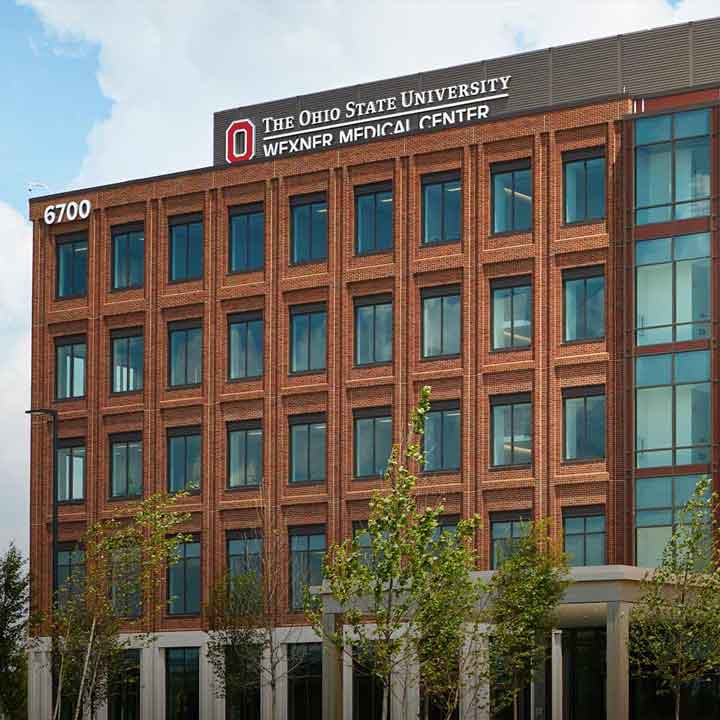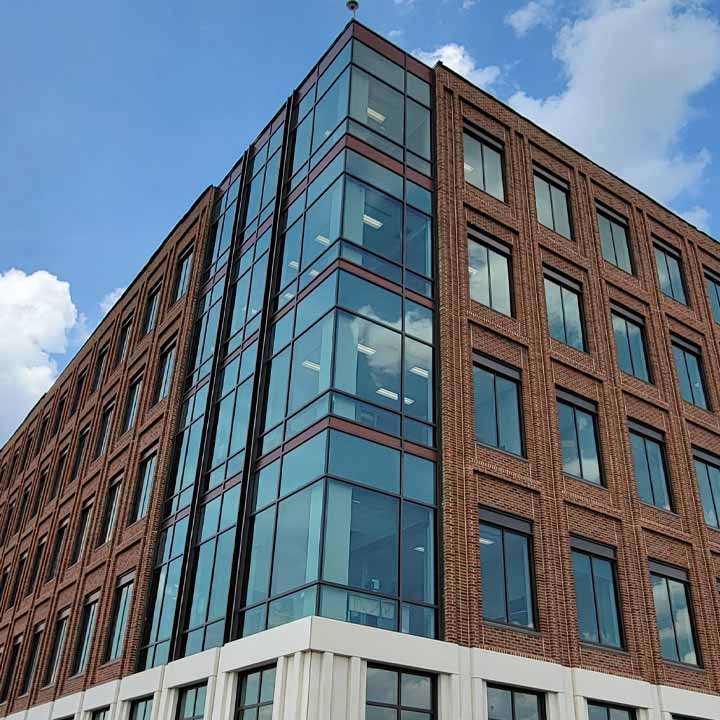 ACL reconstruction surgery restores a torn anterior cruciate ligament (ACL). When you sustain a torn ACL, it can be devastating, especially for athletes. At The Ohio State University Wexner Medical Center, our expert knee specialists understand that the sudden halt to an active lifestyle caused by an ACL tear can be painful not only physically but also psychologically. That’s why we strive to provide the most advanced knee treatments and surgical techniques available to get you back to the sport you love as quickly as possible.
ACL reconstruction surgery restores a torn anterior cruciate ligament (ACL). When you sustain a torn ACL, it can be devastating, especially for athletes. At The Ohio State University Wexner Medical Center, our expert knee specialists understand that the sudden halt to an active lifestyle caused by an ACL tear can be painful not only physically but also psychologically. That’s why we strive to provide the most advanced knee treatments and surgical techniques available to get you back to the sport you love as quickly as possible.
What is ACL reconstruction surgery?
The anterior cruciate ligament (ACL) is a strong band of tissue that attaches the shinbone to the thighbone in the center of the knee. Tearing this ligament is common among athletes, especially those engaged in cutting or pivoting sports like soccer, football, basketball, rugby or lacrosse. However, an ACL tear can happen to anyone from a direct hit or when you stop or change direction suddenly, land improperly, or slow down while running.
ACL reconstruction surgery is commonly used to treat complete tears, especially for athletes. In an ACL reconstruction, a new ligament is built from a graft that comes from another part of your body or a donor. Surgery is often performed four to six weeks after a torn ACL. This approach gives time for a preoperative exercise program to work on quadriceps activation and strength, full knee range of motion and swelling reduction.
During ACL reconstruction, our knee surgeons may also fix other injured areas of the knee, such as a tear in the meniscus, cartilage or other knee ligaments, at the same time.
ACL repair vs. reconstruction
In some situations, we’re able to repair a torn ACL by reattaching the original ligament to the bone, but this is possible only in very specific cases based on the tear location, severity and your age.
Reconstruction of the ACL involves using a new graft of tissue to rebuild and restore the ligament.
Who is a candidate for ACL reconstruction surgery?
Not everyone is a candidate for ACL reconstruction surgery. For people who are low-impact athletes or don’t plan to return to sports, nonsurgical treatment methods, such as physical therapy and bracing, might manage their condition.
We usually recommend ACL reconstruction if you’re younger and plan to continue participating in cutting and twisting sports, have additional injuries to your knee or continue to feel unstable even after nonsurgical treatment.
How is ACL reconstruction surgery performed?
ACL reconstruction surgery may look slightly different for each person, depending on various factors. However, it typically follows these steps:
- An intravenous (IV) line will be placed, and you’ll be given general anesthetics to put you to sleep, so you won’t feel anything during the surgery. Sometimes other types of anesthetics are used.
- The first step in ACL reconstruction is obtaining the tendon graft that will be used to reconstruct the torn ACL, if it’s not from a donor (an allograft). An autograft is a graft that is harvested from your own body. In most cases, a portion of the patellar tendon, hamstring tendon or quadriceps tendon is harvested from the same knee, but sometimes we use the opposite knee.
- After the graft has been harvested, the surgeon prepares it by trimming and cleaning the tissue and tagging the ends with stitches. The same is done to a donor graft.
- Then, the surgeon performs an arthroscopic evaluation of your knee using two or three incisions around the knee. An arthroscope is a small tube that has a camera and light attached to it to see inside the knee joint through these minimally invasive incisions.
- The surgeon will address any meniscus tears and other injuries before beginning work on the ACL tear.
- The torn ACL is removed to allow room for the new graft. Then, a tunnel is created in both the thighbone and the shinbone. The graft is passed through the tunnels and secured.
- Before the incisions are closed, your surgeon will bend and straighten your knee several times to check for the right amount of tension and stability.
- After a final inspection, incisions are closed, and a sterile dressing is applied with a compression wrap and a cold pack.
What to expect with ACL reconstruction surgery?

Undergoing a procedure like ACL reconstruction can be intimidating, but knowing what to expect before, during and after surgery can help ease some nerves. Our excellent knee surgery team will be with you every step of the way.
Preparing for ACL surgery
As soon as you have your ACL surgery date, call to schedule both your presurgery and postsurgery physical therapy visits. During your preoperative evaluation, the physical therapist will teach you exercises to better prepare you for surgery and to help your recovery go more smoothly. It’s important that you do the exercises daily, so you do not lose any knee motion or strength.
Before your surgery, tell your providers about any medicines you take, including vitamins and supplements. They’ll advise you about what you can and shouldn’t take in the days leading up to surgery.
Other important things to note in the days and weeks leading up to surgery:
- Manage any swelling with ice, wraps and elevation.
- Use crutches or other devices as instructed.
- Try to quit smoking for the four weeks prior to surgery and the eight weeks after to help your wounds heal. Cessation services are available.
- Find someone to take you to and from the hospital and help you get settled back at home on the day of your surgery.
During ACL surgery
You’ll be asleep during surgery, so you won’t feel any pain. ACL surgery lasts about one to two hours, depending on whether other areas are repaired at the same time.
You’ll recover at the hospital for roughly two hours after surgery before being able to head home. Plan to be at the hospital for at least six hours.
After ACL surgery
After surgery, you’ll be transported to the post-anesthesia care unit (PACU). A nurse will review instructions regarding weight-bearing, activity levels and medications with you and the person driving you home. A physical therapist will meet with you regarding crutch training and home exercises.
The effects of anesthesia may remain for 24 hours or longer. Do not drive, operate equipment or make important decisions during this time.
How long does it take to recover from ACL surgery?
Recovery from ACL reconstruction varies from person to person, but most people can resume most activities in a few weeks to months, with the exception of high-impact activities. Sometimes the recovery period is close to a year for athletes returning to competitive sports. Here are some tips to help your recovery progress smoothly:
- Schedule follow-up visits with your surgeon or physical therapists.
- Protect your knee by correctly using crutches or a brace, following your surgeon’s motion and weight-bearing restrictions and elevating the knee to prevent swelling.
- Use your cold therapy unit as directed by your surgeons.
- Keep your incisions dry for three days, and after that, don’t allow water to directly touch the incisions; don’t soak the site in a bath or pool until the incisions have completely healed.
- Use Ace wrap to control swelling.
- Take anti-inflammatory medications as directed.
- Be diligent in completing all leg exercises daily, even if it feels uncomfortable, and attending your physical therapy appointments.
- Call your doctor right away if you have any signs of infection at the incision site, signs of blood clots (severe calf pain or swelling, chest pain, shortness of breath), or excessive bleeding.
When will I walk after ACL surgery?
You should be able to walk with crutches on the day of surgery. You’ll begin your physical rehabilitation program a few days after surgery to restore strength, stability and range of motion to the knee. A typical therapy schedule is two to three times a week for up to two months.
If you are an athlete who is returning to sports after ACL reconstruction surgery, here are important considerations:
- Stay involved with your team. You can still be learning and maintaining fitness on the sidelines even though you are injured.
- Discuss what physical activity you can do with your physical therapist. Core work, stationary cycling, upper extremity strengthening and rehab exercises all might be options.
- Remember, every athlete recovers at a different pace. You might feel fit and ready to return to some activities four to six weeks after surgery, but you should verify the plan with your care team. Keep your coach involved in your progress, too.
Benefits of ACL reconstruction surgery
The major benefit of ACL reconstruction surgery is it allows athletes and highly active people to continue to play the sports they love. Other benefits include:
- Restoration of normal or near-normal function in the knee
- Improved stability
- Decreased pain and increased range of motion
- Reduced risk of further knee damage
Risks of ACL surgery
ACL reconstruction is generally a safe procedure, but just like with any surgery, there can be complications. These risks include:
- Infection at the surgical site
- Blood clots
- Pain, stiffness or swelling that doesn’t subside in the weeks following surgery
- Nerve damage
- Graft failure (when you tear the ACL graft again)
Our knee surgeons and team will take every precaution to ensure you don’t experience these risks, and it’s important to talk to your doctor about any concerns or possible complications.
 Why choose Ohio State for ACL reconstruction surgery
Why choose Ohio State for ACL reconstruction surgery
Not only is the Ohio State Wexner Medical Center home to orthopedic surgeons with decades of experience in ACL repair and reconstruction, but we have physical therapists, sports medicine rehabilitation programs and active clinical trials dedicated to producing the best outcomes following ACL surgery. As the trusted team physicians for Ohio State athletes and professional and Olympic athletes across the country, we bring this same elite level of care to your ACL injury.

 ACL reconstruction surgery restores a torn anterior cruciate ligament (ACL). When you sustain a
ACL reconstruction surgery restores a torn anterior cruciate ligament (ACL). When you sustain a 
 Why choose Ohio State for ACL reconstruction surgery
Why choose Ohio State for ACL reconstruction surgery




